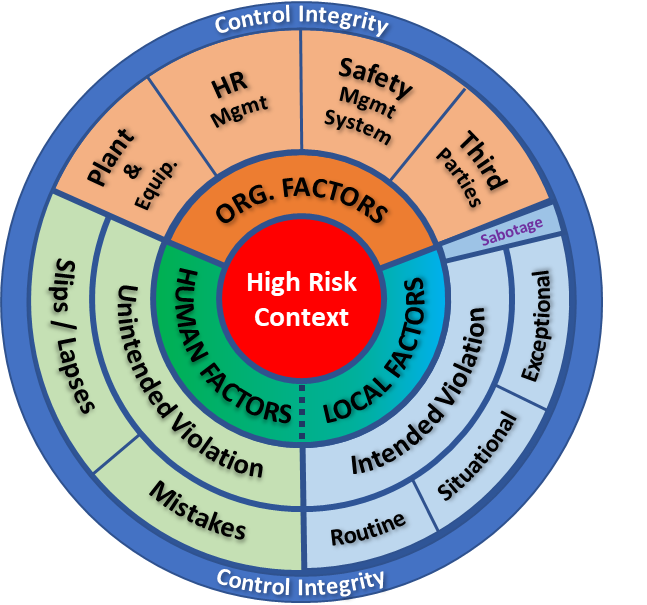
Meta Incident Analysis
35% of incidents do not attract quality analysis*
61% of investigation actions viewed as ineffective*
*Survey of 649 safety professionals, 2010, Drupsteen et al.
Are the real factors behind serious injury & fatality exposure properly understood?
Many operations struggle to realise full benefit from their effort to investigate incidents and the corrective actions that follow. This means that weak controls aren’t identified or are left unaddressed, and serious incidents tend to repeat over time. Regardless of their cultural maturity, most organisations struggle to achieve consistent, quality analysis of incident causal factors. So, it is little wonder that a recurrence of serious incidents can feel like ‘Groundhog Day’.
Common pitfalls of typical incident management systems include:
categorisation of incidents based on actual rather than potential severity outcome
biases in data gathering, interpretation, analysis and decision-making
a lack of understanding of how to improve human reliability within critical risk activities
lag-based performance metrics that don’t provide insight into where to focus resources
reward and recognition systems that detract from unbiased, independent incident management
bias towards instant problem solving and production continuity
a lack of capability, quality and consistency in incident investigations.
There is an opportunity to learn much more from events with potential for serious consequence. The Meta Incident Analysis process (which incorporates the Incident Severity Analysis) examines multiple incidents with similar exposure types that have occurred over a six to 24-month time frame. Armed with a rigorous framework, the analysis isolates the precursors to serious incidents. It also identifies the system and culture factors that perpetuate undesirable exposure and result in repeat incidents. The result is a comprehensive and pragmatic set of recommendations to support improvement.
Armed with a rigorous framework, the analysis isolates the precursors to serious incidents by analysing which controls break down, and why.
It identifies the system and culture factors that perpetuate undesirable exposure and result in repeat incidents.
It also examines the efficacy of the learning and action development system.
The result is a comprehensive and pragmatic set of recommendations to support improvement.
The Solution
Incident Severity Analysis equips leaders with more accurate data, enabling them to respond to, inquire about and provide precious resources to the high severity events that matter most.
Impartial and independent, the Incident Severity Analysis includes a review of incident data, including output from incident investigations.
It tests and reports on the accuracy of corporate incident severity classification and breaks down that analysis by business division and/or operation. It also reports on the prevalence of high-severity potential events across certain high-risk activities,2 allowing you to pinpoint key opportunities to improve safety outcomes.
We utilise a specific set of criteria for high-risk work contexts to analyse severity potential across all relevant operating situations, with incidents and near misses treated equally in determining the real potential for serious injury or fatality.
The analytical methodology that sits behind the analysis provides a consistent, accurate and repeatable process to determine which incidents should get attention from leaders and safety teams.
Analytical Process
Analysis Outputs
A comprehensive dashboard and report to enable better decision making around:
identification and prioritisation of critical risk work
improvement of severity classification system (to prioritise limited resources on high-severity potential incidents)
gaps in critical control management for high-risk exposure activities
human factors that could be influencing high-severity potential events (e.g. autopilot, urgency, cognitive fatigue)
local factors such as supervision that could be more effective
organisational factors that if addressed could reduce exposure to critical risk (e.g. maintenance, pre-work planning)
improvement of corrective actions such as effectiveness of critical controls, leadership, pre-planning, human error, supervision of high-risk work
improvement of the effectiveness and outputs of investigations into serious injury and fatality (SIF) potential events.
The Outcome
Take a deep dive into your serious incident data and learn how your organisation can better manage high-risk work activities to improve safety outcomes. Through the Meta Incident Analysis process, you will understand:
how to refine your severity classification system to prioritise your limited resources on the incidents that matter most
the types of high-severity potential incidents that are routinely flying under the radar which incidents are being misclassified and therefore receiving disproportionate attention
which high-risk exposure activities are most likely to be poorly controlled
the frequency of high potential events within high-risk categories of work
the human, local and organisational factors leading to high-severity potential events that require attention
the effectiveness of your organisation’s corrective actions and investigation outputs.
Request a demo to learn what Incident Analytics can do for your organisation.
Thirty minute virtual walk-throughs available by appointment.





